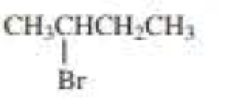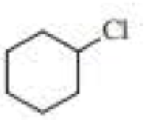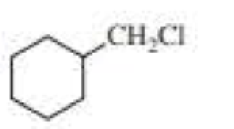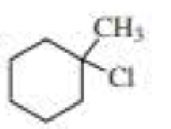
ORGANIC CHEMISTRY-W/S.G+SOLN.MANUAL
8th Edition
ISBN: 9780134595450
Author: Bruice
Publisher: PEARSON
expand_more
expand_more
format_list_bulleted
Concept explainers
Textbook Question
Chapter 9, Problem 83P
Draw the major product obtained when each of the following






Expert Solution & Answer
Trending nowThis is a popular solution!

Students have asked these similar questions
10
5
4. These four 'H NMR spectra were recorded from different isomers with molecular formula
CsH,CIO. They all contain a carbonyl group. Determine the structure of the different isomers.
0
10
5
0
10
5
10
9
8
7
6
5
4
3.
1
0
9
10
10
66
9
0
10
9
10
5
1
8
7
6
5
3
2
-a
8
7
6
5
1
10
9
8
7
6
5
22
2
1
0
3
2
16
1
0
3
2 1
2
6
0
Use the expression below to
⚫ calculate its value and report it to the proper number of significant digits (you may need to
round your answer).
⚫ calculate the % error (or % relative error or % inherent error)
⚫ calculate the absolute error.
(20.54±0.02 × 0.254±0.003) / (3.21±0.05) =
Value:
% Error:
Absolute error: ± |
% (only 1 significant digit)
(only 1 significant digit)
In each case (more ductile, more brittle, more tough or resistant), indicate which parameter has a larger value.
parameter Elastic limit Tensile strength
more ductile
Strain at break Strength Elastic modulus
more fragile
more tough or resistant
Chapter 9 Solutions
ORGANIC CHEMISTRY-W/S.G+SOLN.MANUAL
Ch. 9.1 - Prob. 3PCh. 9.1 - Does increasing the energy barrier for an SN2...Ch. 9.1 - Rank the following alkyl bromides from most...Ch. 9.1 - Prob. 8PCh. 9.2 - Prob. 9PCh. 9.2 - Prob. 10PCh. 9.2 - Prob. 11PCh. 9.2 - Prob. 12PCh. 9.2 - Which substitution reaction lakes place more...Ch. 9.2 - Prob. 15P
Ch. 9.2 - Prob. 17PCh. 9.3 - Prob. 18PCh. 9.4 - Prob. 19PCh. 9.5 - Draw the configuration(s) of the substitution...Ch. 9.5 - Which of the following reactions take place more...Ch. 9.7 - Prob. 22PCh. 9.7 - Prob. 23PCh. 9.7 - Prob. 24PCh. 9.7 - Prob. 25PCh. 9.8 - Four alkenes are formed from the E1 reaction of...Ch. 9.8 - If 2-fluoropentane could undergo an E1 reaction,...Ch. 9.8 - Prob. 28PCh. 9.8 - Propose a mechanism for the following reaction:Ch. 9.9 - Prob. 30PCh. 9.9 - What percentage of the reaction described in...Ch. 9.10 - Prob. 33PCh. 9.10 - Prob. 35PCh. 9.11 - Why do cis-1-bromo-2-ethylcyclohexane and...Ch. 9.11 - Which isomer reacts more rapidly in an E2...Ch. 9.11 - Prob. 38PCh. 9.12 - Prob. 39PCh. 9.12 - Prob. 40PCh. 9.12 - Prob. 41PCh. 9.12 - Explain why only a substitution product and no...Ch. 9.12 - a. Explain why 1-bromo-2,2-dimethylpropane has...Ch. 9.13 - Prob. 44PCh. 9.13 - Prob. 45PCh. 9.13 - What products will be obtained from the El...Ch. 9.13 - Prob. 47PCh. 9.13 - Prob. 48PCh. 9.13 - Prob. 49PCh. 9.13 - Why is a cumulated diene not formed in the...Ch. 9.13 - What product is obtained when the following...Ch. 9.13 - What products are formed from the following...Ch. 9.14 - Prob. 54PCh. 9.14 - Prob. 55PCh. 9.14 - Prob. 56PCh. 9.14 - Prob. 58PCh. 9.14 - Under which of the following reaction conditions...Ch. 9.15 - A small amount of another organic product is...Ch. 9.15 - What is the best way to prepare the following...Ch. 9.15 - Prob. 62PCh. 9.15 - What products (including stereoisomers, if...Ch. 9.16 - After a proton is removed from the OH group, which...Ch. 9.16 - Prob. 65PCh. 9.17 - Prob. 66PCh. 9 - Prob. 1PCh. 9 - Methoxychlor is an insecticide that was intended...Ch. 9 - Prob. 67PCh. 9 - Prob. 68PCh. 9 - Prob. 69PCh. 9 - Prob. 70PCh. 9 - Prob. 71PCh. 9 - Prob. 72PCh. 9 - Starting with cyclohexene, how can the following...Ch. 9 - Prob. 74PCh. 9 - The pKa of acetic acid in water is 4.76. What...Ch. 9 - Prob. 76PCh. 9 - Prob. 77PCh. 9 - Prob. 78PCh. 9 - Prob. 79PCh. 9 - Prob. 80PCh. 9 - Prob. 81PCh. 9 - Prob. 82PCh. 9 - Draw the major product obtained when each of the...Ch. 9 - Prob. 84PCh. 9 - a. Indicate how each of the following factors...Ch. 9 - Prob. 86PCh. 9 - A chemist wanted to synthesize the...Ch. 9 - Prob. 88PCh. 9 - Prob. 89PCh. 9 - Prob. 90PCh. 9 - Prob. 91PCh. 9 - Starting with an alkyl halide, how could the...Ch. 9 - Indicate which species in each pair gives a higher...Ch. 9 - Prob. 94PCh. 9 - Rank the following from most reactive to least...Ch. 9 - For each of the following alkyl halides, indicate...Ch. 9 - Prob. 97PCh. 9 - When 2-bromo-2,3-dimethylbutane reacts with a...Ch. 9 - Prob. 100PCh. 9 - When the following compound undergoes solvolysis...Ch. 9 - cis-1-Bromo-4-tert-butylcyclohexane and...Ch. 9 - Draw the substitution and elimination products.Ch. 9 - tert-Butyl chloride undergoes solvolysis in both...Ch. 9 - Prob. 105PCh. 9 - Prob. 106PCh. 9 - In which solventethanol or diethyl etherwould the...Ch. 9 - Prob. 108PCh. 9 - Two bromoethers are obtained from the reaction of...Ch. 9 - Prob. 110PCh. 9 - Prob. 111PCh. 9 - Prob. 112PCh. 9 - Which of the following hexachlorocyclohexanes is...Ch. 9 - Explain why the rate of the reaction of...Ch. 9 - Prob. 115PCh. 9 - Two elimination products are obtained from the...Ch. 9 - Draw the structures or the product of the obtained...Ch. 9 - How could you prepare the following compounds from...Ch. 9 - cis-4-Bromocyclohexanol and...Ch. 9 - Prob. 120PCh. 9 - Propose a mechanism for the following reaction:Ch. 9 - Prob. 122PCh. 9 - Prob. 123PCh. 9 - Prob. 124PCh. 9 - Prob. 125PCh. 9 - Predict the product for the following reaction and...Ch. 9 - Prob. 127PCh. 9 - Prob. 128PCh. 9 - When equivalent amounts of methyl bromide nod...Ch. 9 - Prob. 130PCh. 9 - The reaction of chloromethane with hydroxide ion...
Knowledge Booster
Learn more about
Need a deep-dive on the concept behind this application? Look no further. Learn more about this topic, chemistry and related others by exploring similar questions and additional content below.Similar questions
- Nonearrow_forwardWhat functional groups are present in this IRarrow_forwardIn each case (more ductile, more brittle, more tough or resistant), indicate which parameter has a larger value. parameter Elastic limit Tensile strength more ductile Strain at break Strength Elastic modulus more fragile more tough or resistantarrow_forward
- 4) A typical bottle of pop holds carbon dioxide at a pressure of 5 atm. What is the concentration of carbon dioxide in th solution? 5) A stream flowing over rocks and such is exposed to the atmosphere and well aerated. What would be the nitrogen concentration in the water at 25°C? (Air pressure is 1.000 bar.)arrow_forwardUse the expression below to ⚫ calculate its value and report it to the proper number of significant digits (you may need to round your answer). ⚫ calculate the % error (or % relative error or % inherent error) ⚫ calculate the absolute error. (30.078±0.003) - (20.174±0.001) + (9.813±0.005) = Value: % Error: absolute error: ± % (only 1 significant digit) (only 1 significant digit)arrow_forwardDon't used Ai solution and don't used hand raitingarrow_forward
- Circle the letter next to the most appropriate response. 1) Which is likely to be the least soluble with water? a) hexane b) acetone c) trichloromethane d) trinitro-toluene 2) Which is likely to be the most soluble in 3,4-dimethyloctane? a) hexane b) acetone c) trichloromethane d) trinitro-toluene 3) When ammonium nitrate is dissolved in water, the solution: a) gets warmer. b) gets colder. c) stays the same temperature. d) is none of the above because potassium nitrate is insoluble.arrow_forwardNonearrow_forwardCircle the compound below that you predict to be least soluble in water and explain yourselection. Please provide a throrough understanding.arrow_forward
- itled [ The America | 241932100 交量 x Hanil Eco So | Question 5 ilearn.laccd.edu 0.5/0.5 pts How many amino acids do you see in the following structure? H3N-CH-C-N-CH-C-N-CH-C-N-CH-C-0- E-N-CH-E-N-CH-C-O- H₁C-CH | | H CH2 H CH₂ H CH2-C-NH2 CH3 CHANH, 6 ○ 5 3 4 H N 5 ptsarrow_forwardNonearrow_forwardNonearrow_forward
arrow_back_ios
SEE MORE QUESTIONS
arrow_forward_ios
Recommended textbooks for you
 Organic ChemistryChemistryISBN:9781305580350Author:William H. Brown, Brent L. Iverson, Eric Anslyn, Christopher S. FootePublisher:Cengage Learning
Organic ChemistryChemistryISBN:9781305580350Author:William H. Brown, Brent L. Iverson, Eric Anslyn, Christopher S. FootePublisher:Cengage Learning

Organic Chemistry
Chemistry
ISBN:9781305580350
Author:William H. Brown, Brent L. Iverson, Eric Anslyn, Christopher S. Foote
Publisher:Cengage Learning
Alcohols, Ethers, and Epoxides: Crash Course Organic Chemistry #24; Author: Crash Course;https://www.youtube.com/watch?v=j04zMFwDeDU;License: Standard YouTube License, CC-BY